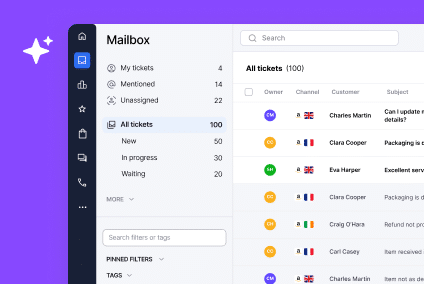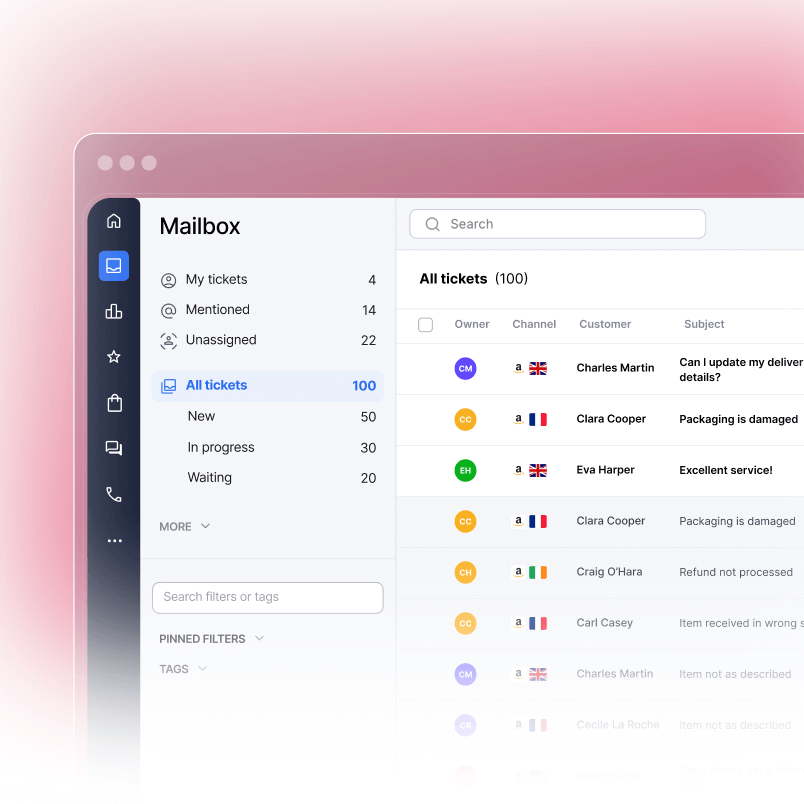Here’s the truth: the customer support software your B2B company uses probably won’t cut it for your eCommerce store. We know this because the two business models operate in completely different universes. Your B2B customers expect quarterly business reviews and dedicated account managers. Your eCommerce shoppers want instant answers at 2 a.m. on a Saturday. They’re operating on different timelines, with different expectations, and different pain points.
Consider this: 90% of customers say an immediate response is important or very important, with 60% defining immediate as 10 minutes or less. That expectation simply doesn’t exist in B2B relationships. Meanwhile, 96% of consumers will leave a brand for a poor customer service experience. Your support infrastructure needs to reflect this reality.
If you’re running an eCommerce business and trying to force a B2B support tool into the mix, you’re likely burning through budget without seeing real results. Let’s break down why eCommerce support software stands apart, and what you should actually look for when choosing the right platform.
What is eCommerce customer support software?
eCommerce customer support software is a specialized platform built to handle the unique demands of online retail. Unlike general helpdesk tools, these solutions are designed specifically for stores selling directly to consumers across multiple channels, including marketplaces like Amazon and eBay, your website, and social media platforms.
The software centralizes all customer inquiries in one place. Whether someone contacts you through a marketplace message, an email, or a chat on your website, everything flows into a single inbox. Your team spends less time jumping between platforms and more time actually helping customers.
For online retailers, speed matters. Customers expect responses within hours, not days. Your support software needs to handle high message volume without slowing down, and it needs to make it easy for your team to stay organized when handling hundreds of inquiries simultaneously. In fact, companies that lead in customer experience grow revenue 80% faster than their competitors, which makes every interaction count toward your bottom line.
How eCommerce support differs from B2B support
The fundamental difference comes down to customer expectations and business relationships. In B2B, relationships develop over months or years. Decision-making cycles are long. Support interactions are often fewer in number but more complex in scope.
eCommerce operates in fast-forward mode. A customer buys from you once, maybe twice, then decides whether to come back. Your support team has a narrow window to create an experience so good that they choose you again. Every interaction counts.
Volume is another massive difference. A B2B company with 100 enterprise clients might handle 50 support tickets per week. An eCommerce store with 10,000 customers might handle 500 inquiries per week during normal periods, and 5,000 during peak seasons. Your support infrastructure needs to scale quickly. In fact, 77% of agents report that their workload has increased over the past year, making efficient systems non-negotiable.
B2B customers tolerate complexity because they have the resources to learn your tools. eCommerce customers have zero patience for complicated processes. They want straightforward solutions, fast responses, and clear information about their order. Research shows that best-performing companies tend to respond to customer tickets within 2 minutes, leaving zero room for friction.
Why B2B tools fall short for online retailers
Standard B2B helpdesk platforms were never designed for the realities of eCommerce. Here’s what breaks down:
Limited multi-channel support. Most B2B tools focus on email and occasionally chat. They don’t understand Amazon seller central, eBay message systems, or the need to manage marketplace communications alongside your website. Your team ends up manually logging into each platform separately, defeating the purpose of having a support system. With 67% of customers finding it convenient to contact businesses on social media, ignoring these channels costs you revenue. Additionally, 48% of customers will abandon brands due to poor omnichannel shopping experiences, making unified support systems non-negotiable.
Inefficient workflows for high volume. B2B tools typically handle tickets sequentially with full context and history. eCommerce needs to process dozens of similar inquiries quickly. A customer asking « where’s my order? » doesn’t need a 10-minute deep-dive investigation; they need their tracking number in 30 seconds.
Missing automation for common issues. eCommerce support involves answering the same questions repeatedly. What’s your return policy? How long does shipping take? Where’s my order? B2B tools don’t anticipate these patterns or help you automate responses. You end up typing manually over and over.
Weak marketplace integration. If you’re selling on Amazon, eBay, or BigCommerce, you need your support software to actually connect to these platforms. Most B2B tools treat marketplace messages as separate work streams. This creates friction and increases response times.
Poor order management visibility. B2B customers rarely ask « where is my purchase? » eCommerce customers ask this constantly. Your support software should show order details, tracking information, and fulfillment status instantly. B2B tools don’t prioritize this integration.
Inadequate for peak season scaling. During holidays or sales events, eCommerce support volume explodes. B2B tools assume steady state. They don’t help you onboard temporary staff quickly or distribute work intelligently across a growing team.
Essential features for eCommerce support platforms
The right platform for your online store needs to handle the specific requirements of selling online. Look for these core capabilities.
Unified inbox across all channels. Your software should bring together messages from your website, email, marketplace messaging systems, and chat. Your team works from one dashboard instead of login hell.
Order lookup and fulfillment visibility. A team member should see an order’s full history, current status, tracking details, and return information without leaving your support platform. This speeds up resolution time dramatically.
Automation and templated responses. Common questions need quick answers. Your software should let you create response templates and automation rules so your team handles routine inquiries efficiently.
Multi-language support. If you ship internationally or serve diverse customer bases, your platform should handle translation and multi-language conversations. This keeps your team focused on helping customers, not translating.
Team collaboration tools. When multiple people need to work on a single inquiry, collaboration features matter. Your software should handle internal notes, task assignment, and hand-offs smoothly.
Performance analytics and reporting. You need visibility into response times, resolution rates, and team productivity. This data helps you identify bottlenecks and improve operations.
Scalability without complexity. Your support software should grow with you. During slow months, you run lean. During peak season, you add temporary staff and handle 10x the volume without system strain.
Multi-channel capabilities for online stores
This is where eCommerce support software separates itself most clearly from B2B alternatives. Your customers live across multiple platforms, and your support team needs to manage all of them efficiently.
Amazon and marketplace integration. If you’re an Amazon seller, your software needs native integration with Seller Central. The same applies to eBay, Shopify, or BigCommerce if you use these platforms. Messages should appear in your support queue automatically, and you should be able to respond directly without logging into separate platforms.
Email and chat handling. These remain core channels. Your platform should unify email conversations with chat interactions so customers get consistent service regardless of how they reach you.
Social media messaging. Customers increasingly contact businesses through Facebook Messenger, Instagram Direct Messages, and WhatsApp. Your support software should consolidate these conversations too.
Ticket management across channels. One customer might email you, then chat, then message on Amazon. Your software should understand that all three interactions belong to the same person and same issue. This prevents frustration and speeds resolution.
The benefit of true multi-channel support is that your team stays organized and customers feel heard. There’s no « sorry, I don’t see your previous email » moments. Everything connects.
Integration requirements for eCommerce businesses
Your support software doesn’t work in isolation. It needs to talk to the other tools running your business.
Marketplace connections. Direct integration with Amazon, eBay, Shopify, BigCommerce, and other selling platforms is non-negotiable. Without these connections, you’re manually copying information between systems, which wastes time and introduces errors.
Inventory management systems. Your support team sometimes needs to know stock levels or check if an item is being discontinued. Integration with your inventory system prevents your team from giving wrong information.
Shipping and fulfillment partners. When a customer asks for tracking information, your software should pull this directly from your shipping provider. This saves your team time and gives customers immediate answers.
Payment and refund systems. Refund requests need quick resolution. Your software should connect to your payment processor so your team can process refunds without leaving the support interface.
CRM and customer data. Historical customer information helps your team provide better support. Integration with your CRM ensures your team has context on previous purchases and interactions.
Email and communication platforms. Email integration should be seamless so email conversations flow naturally into your support system without manual intervention.
How to choose the right eCommerce support software
Selecting the right platform for your business requires looking beyond surface-level features. Here’s what we recommend evaluating.
Assess your current pain points. Are you losing customers because response times are too slow? Are your team members burned out from jumping between systems? Is peak season chaos? Identify what hurts most, then prioritize solutions that fix those specific problems.
Evaluate marketplace integration depth. If you sell on specific platforms, make sure the software integrates deeply with those platforms. Surface-level integration that only works one-way isn’t enough. You need bidirectional sync so responses flow back to customers automatically. Learn more about optimizing these processes by reading our guide on agent SLA tracking for marketplaces.
Test multi-channel handling. Before committing, test how the software actually handles multi-channel conversations. Can it keep track of a customer who bounces between channels? Does it create separate tickets for each channel or treat them as one conversation?
Check automation capabilities. Look for smart automation that actually saves time. Can you set up conditional responses? Do automation rules work across channels? Can you automate order status updates or shipping notifications?
Review reporting and analytics. You need data to improve. Make sure the software provides the metrics that matter to your business. Response time, resolution rate, and team productivity are baseline. Look for features that help you spot patterns and trends.
Consider scalability and cost. During slow months, you might need support for three team members. During peak season, you might need six. Make sure pricing scales with your team size and doesn’t lock you into paying for unused capacity year-round.
Look at ease of use. Your support team will use this software 8 hours a day. If it’s unintuitive or clunky, adoption will suffer. Simple interfaces and straightforward workflows matter more than bells and whistles.
Check customer support quality. The software vendor should offer responsive support when issues arise. You’re trusting them to handle customer interactions. Make sure they take support seriously.
Final thoughts
Looking at how your support approach impacts your bottom line matters too. Companies investing in better customer service can increase revenue by up to $700 million within three years. Meanwhile, 64% of customers will switch brands over a single bad service experience. These aren’t small numbers.
Trying to run eCommerce support with B2B software is like trying to grow vegetables in a fish tank. The tank might hold water, but it’s the wrong environment for your specific needs. eCommerce support software exists because online retail operates on completely different principles than B2B relationships.
Your customers expect speed, convenience, and multi-channel access. They want to buy from you once and have such a smooth experience that they come back. Your support team needs tools built for high volume, marketplace integration, and quick resolution. Standard helpdesk software doesn’t deliver on any of these fronts.
Look for a platform designed specifically for online retailers. Prioritize multi-channel unification, marketplace integration, and automation capabilities. Test the software with your actual workflows before committing. For a deeper dive into modern support strategies, check out our guide on AI customer support to see how advanced platforms accelerate response times while maintaining quality.
When you choose eCommerce-specific software, you’re not just improving efficiency. You’re directly protecting revenue and customer loyalty. The right choice will reduce your team’s workload, improve customer satisfaction, and help your business scale without support becoming a bottleneck. When support becomes easy for your team, they serve customers better. When customers get fast, helpful responses, they come back. That’s the difference the right platform makes.
FAQs
Can I use standard B2B helpdesk software for my eCommerce store? Technically yes, but it’s not ideal. B2B tools lack marketplace integration, struggle with high message volume, and don’t prioritize the order visibility your customers need. You’ll spend more time working around limitations than solving customer problems.
What’s the most important feature in eCommerce support software? Multi-channel consolidation is critical. When all customer communications flow into one inbox, your team operates efficiently and customers get consistent responses. Everything else builds on this foundation. For a deeper dive, read our article on 7 ways to optimize your ecommerce helpdesk to see real implementation strategies.
How do I know if my current support setup is inadequate? Signs include: response times longer than a few hours, team members frustrated with tool-switching, customers complaining about slow replies during peak season, or error-prone manual workarounds to connect different platforms. With 54% of customers expecting a response within two hours, response time bottlenecks are deal-breakers. Additionally, 61% of consumers are willing to spend at least 5% more if they know they’ll receive good customer experience. Check our customer support metrics guide to benchmark your performance against industry standards.
Should I choose software with more features or simpler software? Choose based on your actual needs. A fully-featured platform is worthless if your team doesn’t use most of the features. Start with core functionality that solves your biggest problems, then add complexity only if it genuinely helps.
How much does eCommerce support software typically cost? Pricing varies widely based on team size, message volume, and feature complexity. Entry-level solutions start around $50 to $100 per month. Mid-range platforms run $200 to $500 monthly. Enterprise solutions scale higher. Compare pricing against the time and efficiency gains you’ll see.
What’s the difference between eCommerce support software and a chatbot? Support software is built for your team to manage all customer interactions from one place. Chatbots automate responses to common questions. Most eCommerce businesses benefit from both. Support software handles the complex issues humans need to solve. Chatbots handle routine questions so your team focuses on higher-value work.
Can I integrate eCommerce support software with my existing tools? Most quality platforms integrate with common eCommerce systems, shipping providers, and payment processors. Before purchasing, verify that the software supports the specific tools you use today and plan to use tomorrow.




